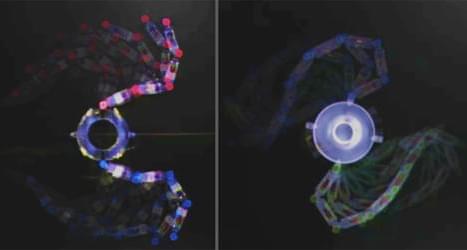How an alga synchronizes its two flapping cilia to propel itself is revealed in a tabletop experiment with chains of mobile robots.
The freshwater alga Chlamydomonas reinhardtii swims by flapping its two cilia in a motion akin to the breaststroke. Unlike a human, C. reinhardtii lacks a brain to coordinate its limbs. The synchronization is automatic. To uncover its origin, Mingcheng Yang of the Institute of Physics of the Chinese Academy of Sciences and his collaborators built mechanical algae whose cilia are made of chains of cockroach-sized toy robots [1]. By adjusting the cilia’s flapping frequency and other parameters, the researchers reproduced the alga’s swimming gaits and identified the conditions that favor them.
Yang’s mechanical algae each consists of a puck-like base, on the sides of which are attached two chains of four robots. Each robot’s underside bristles with elastic hairs set at an angle. When a mechanical alga is placed on a tabletop and an internal electric motor is switched on, each bristly robot vibrates vertically. On the upstroke, the hairs push the robot toward the base, setting up the possibility that the chains could buckle.
